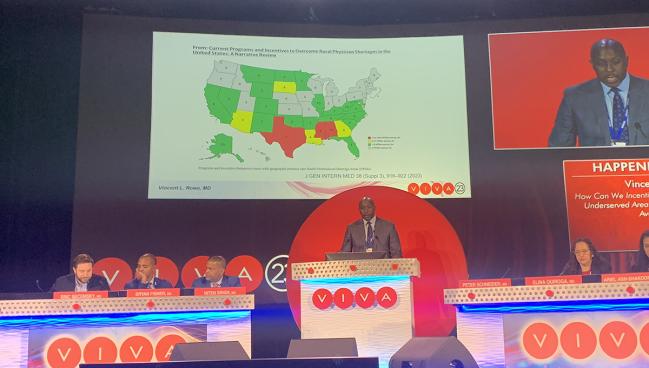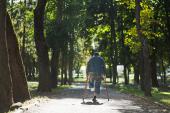‘Dire’ Lack of Vascular Care in Underserved Areas Needs Creativity, Compassion
Advocacy, a training bus, and an interactive map of excess amputations are all potential tools in this fight, experts say.

LAS VEGAS, NV—Getting more vascular specialists to work with underserved communities is a significant problem without easy answers, but in a session here at VIVA 2023, experts discussed how local and nationwide initiatives could go a long way toward improving the situation.
Currently, there are more than 2,600 counties in the United States with no practicing vascular surgeons, highlighted Vincent Rowe, MD (David Geffen School of Medicine at UCLA, Los Angeles, CA). That translates to 96 million people in roughly half of all urban counties being underserved.
Rowe said the combination of the COVID-19 pandemic’s impact on training, retirement, and burnout, coupled with an increasingly comorbid elderly population, has created a shortage in the vascular world that some experts predict won’t be rectified until at least 2050.
“It seems like there's not much that we can do and it's a pretty dire situation, but I do have some suggestions that can really help us,” Rowe said. “If we go to what's the incentive [for recruitment], a lot of people say it's just money. Hopefully, that's not [all] that we have to entice people to work in some of these communities.”
States that have the greatest need for vascular specialists, like Texas, Mississippi, and Alabama, tend to have the most programs in place to try to recruit physicians willing to work in underserved populations. Current recruitment methods include loan repayment programs, educational opportunities and fellowships, assistance with visas, and a focus on retention of physicians to keep them once they’ve come to work in the area rather than just temporarily redistributing them, Rowe added, but more solutions like these are needed.
I think it’s really up to all of us to say: ‘Can we shift and make a difference together?’ Vincent Rowe
Another potential solution that Rowe outlined is a mobile “pipeline to healthcare.” The concept consists of a large bus equipped with endovascular and laparoscopic stations, a suturing station, and a robotic station. The idea is to use the truck to show young people interested in entering healthcare what is possible in the vascular field.
“We can park it anywhere and just recruit new kids into the healthcare field,” Rowe said. “We’re going to have to go get them. We just can’t wait for them to come in.” He said the idea was inspired in part by the story of Jann Mardenborough, a British teen who became a professional driver after training on a PlayStation video game then won a worldwide competition that lets the game’s best players race in real cars.
Still to this day, we allow patients to have their legs cut off without workup. Bryan T. Fisher
Niten Singh, MD (Harborview Medical Center, Seattle, WA), who moderated the session, said while he likes the idea of the training bus, the larger question is who is going to fund it.
For Rowe, one answer is industry. He noted that true action will only come from advocating for help from those who can provide it. “We can have somebody fly us to talk here and talk there—a couple more lines on our CV—but what are we doing?” Rowe asked. In addition to industry, he said, other untapped resources may be out there to help with things like funding PAD screening in areas where the need for vascular care is greatest.
That segues to another important aspect in the discussion of disadvantaged populations: physician accountability.
“In 2023, we still have patients that walk into an office and are given zero options and they end up with their leg gone,” said Bryan T. Fisher, MD (TriStar Health, Nashville, TN), who presented his take on the topic during the same session. “Imagine doing that to a patient [who] came with a lump on the breast and the first thing the doctor said is we’ve got to do a double mastectomy. That would not be acceptable. But yet still to this day, we allow patients to have their legs cut off without workup.”
Accountability can be as simple as having patients remove shoes and socks for a foot exam, Fisher added. “I can’t tell you how many of my colleagues have patients with end-stage renal disease, and . . . I have heard them say ‘I don’t even want to see what’s going on down there,’” he noted.
Rowe said that like many physicians, he wasn’t always aware of the scope of the problem underserved PAD patients face. He believes talking about it comes with the additional responsibility of acting on the problem in as many ways as possible to create change.
“I think it’s really up to all of us to say: ‘Can we shift and make a difference together?’” he added.
Seeking Help From Policymakers and Others
An additional potential avenue for advocacy, presented in the session by Eric Secemsky, MD (Beth Israel Deaconess Medical Center, Boston, MA), is an interactive heat map that displays amputation rates by congressional district. Created through the American Heart Association’s PAD National Action Plan and in collaboration with VIVA, the map is expected to go live online soon.
“The goal is to be able to identify areas that are outliers in terms of their amputation rates and identify congressional representatives linked to those districts who can advocate for more resources,” Secemsky told TCTMD. He added that physicians and who care for patients with PAD are the targeted users for this tool.
“[This can] hopefully help put a little pressure on those who represent us to provide more resources, in particular for these areas that have been really lacking the resources to make improvements in vascular care,” he added.
L.A. McKeown is a Senior Medical Journalist for TCTMD, the Section Editor of CV Team Forum, and Senior Medical…
Read Full BioSources
Rowe V. How can we incentivize people to practice in underserved areas? What resources are available? Presented at: VIVA 2023. November 1, 2023. Las Vegas, NV.
Secemsky EA. Amputation trends around the country. Presented at: VIVA 2023. November 1, 2023. Las Vegas, NV.
Fisher B. Putting it all together: Who is doing this the right way? Presented at: VIVA 2023. November 1, 2023. Las Vegas, NV.
Disclosures
- Rowe reports no relevant conflicts of interest.
- Fisher reports honoraria from Abbott Vascular, BD, Philips, Veryan, and Shockwave Medical; and consulting for Abbott Vascular, Shockwave Medical, and Philips.
- Secemsky reports consulting for Boston Scientific, BD, Cook Medical, Cardiovascular Systems Inc, Philips, Medtronic, and VentureMed.





Comments